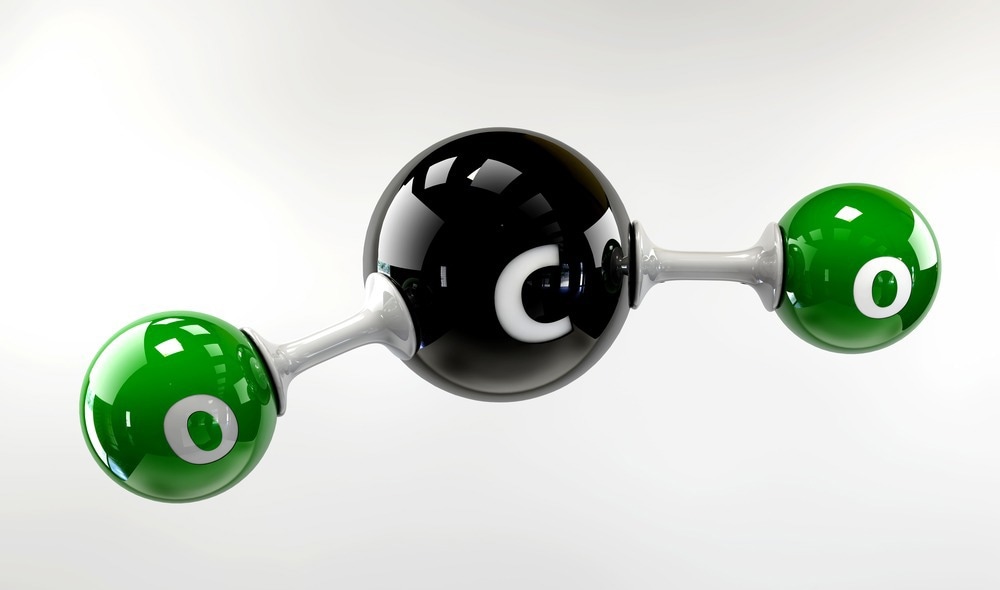The insertion of active sites on the surface can improve the photocatalytic activity of certain materials. However, creating these sites on specialized photocatalyst surfaces is challenging due to a lack of knowledge of the atomic-level structural behavior.

Study: Facet-specific Active Surface Regulation of BixMOy (M=Mo, V, W) Nanosheets for Boosted Photocatalytic CO2 reduction. Image Credit: Victor Josan/Shutterstock.com
A recent study published in the journal Angewandte Chemie International Edition tackles this issue by reporting a facile sonication-assisted specific facets regulation for bismuth (Bi)-based photocatalyst. The defects introduced on the highly reactive surface of the photocatalyst enhance charge transfer and decrease the energy threshold for CO2 reduction.
Photocatalytic CO2 Reduction: Overview and Significance
During CO2 reduction, electrical energy converts carbon dioxide (CO2) to a more reduced reactive species. CO2 reduction using a semiconductor-based photocatalyst is extensively used for carbon absorption and the creation of green energy. However, the thermally resilient CO2 molecules and inactive photocatalyst surfaces create a large energy threshold for CO2 reduction.
Surface modifications, such as surface imperfections, single molecules, and active groups, can enhance charge transfer and reactivity in photocatalytic CO2 reduction. These modifications to the surface of the photocatalyst increase the reactive sites and their coordination structure, boosting the activity and efficiency of the photocatalyst for CO2 conversion.
This occurs because photoinduced surface charges are reallocated during surface-regulated modification, with electrons concentrating near active sites to enhance reductive processes. In addition, reactive surface groups with an improved coordination structure enable reactant activation and lower the energy threshold for CO2 reduction.
Limitation of Surface Engineering for Photocatalytic CO2 Reduction
Despite these benefits of surface modification, controlling surface defect density at extreme temperatures and substantially reducing circumstances remains impossible since a bulk defect may be easily created, functioning as a fusion center and lowering charge separation effectiveness.
Moreover, oxygen atoms generated from CO2 molecules after the dissolution of C-O bonds can repair the surface void, reducing the photocatalyst's stability and effectiveness.
The insertion of metallic atoms, particularly noble metals, is costly and results in photocatalyst destabilization. Moreover, grafting structural features onto the photocatalyst is difficult because added organic molecules are frequently destroyed with light, resulting in carbon pollution in CO2 reduction.
As a result, more knowledge is required to better manage processes for robust and well-defined surface modification, as well as enhanced photocatalytic CO2 reduction efficiency.
Active surface modulation of crystals may be utilized for improving performance reasonably. The creation of defects under highly reductive reagents and high temperature and pressure allows for controlled surface alteration. However, these processes need costly chemicals and large energy input, resulting in substantial emissions.
Highlights of The Current Study
Sonication is an appealing manufacturing approach for addressing these difficulties since it can be utilized under ambient settings using common reductive reagents to induce cavitation, resulting in localized high temperature and pressure. As a result, sonication treatment may be used to realize CO2 reduction processes that are challenging at room temperature and atmospheric pressure.
The researchers suggested surface-modified Bi-based nanosheets as innovative CO2 reduction photocatalysts in this study. These Bi-based nanosheets were created via a controlled hydrothermal process, and the nanosheets were cleaned to eliminate the organic surfactants.
The sonication-assisted chemical modification was used to alter the surface of the Bi-based nanosheets. Advanced characterization approaches such as synchrotron-based X-Ray absorption near-edge structure (XANES), X-Ray photoelectron spectrometry (XPS), and enhanced X-Ray absorption fine structure (EXAFS) spectrometry were used to study the modified surfaces of the as-prepared nanosheets.
Important Findings of the Research
The surface-modified Bi-based nanosheets demonstrated exceptional photocatalytic CO2 reduction efficiency, outstanding durability, and repeatability compared to an unaltered photocatalyst. This improved functionality of the as-prepared nanosheets is due to the modified surface, which increases CO2 molecule reactivity and improves charge separation.
The researchers also examined the CO2 reduction route and rate-limiting phases. The uppermost surface of photocatalysts is influenced by sonication-assisted surface modification, while the bulk crystalline structure is unaltered.
This promotes electron-hole transfer and CO2 stimulation on the surface while decreasing electron-hole coupling in the bulk sample, as proven by in situ spectrometry, luminescence spectroscopy, and theoretical simulations.
This study's surface-modification technique applies to a wide variety of materials for achieving controlled surface properties and improving photocatalytic performance. Moreover, these discoveries create a dynamic surface engineering method that may be applied to other photocatalytic systems, such as nitrogen reduction, hydrogen evolution, and oxygen transformation.
Reference
Zhang, Y. et al. (2022). Facet-specific Active Surface Regulation of BixMOy (M=Mo, V, W) Nanosheets for Boosted Photocatalytic CO2 reduction. Angewandte Chemie International Edition. Available at: https://doi.org/10.1002/anie.202212355
Disclaimer: The views expressed here are those of the author expressed in their private capacity and do not necessarily represent the views of AZoM.com Limited T/A AZoNetwork the owner and operator of this website. This disclaimer forms part of the Terms and conditions of use of this website.